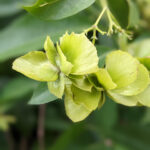Botanical Name: Sambucus nigra
Family Name: Caprifoliaceae
Common Name(s) –Elderberry, elder, European elder, black elder, common elder, elder bush, pipe tree, bore tree, and “Medicine Chest of the People.” Botanical name comes from the Greek word “sambuke” meaning “a musical pipe” in reference to the hollowed shoots which are used to make pipes. The common name of “elder” from the Anglo-Saxon word aeld, meaning “fire,” as the stems were commonly used as kindling.
Origin – Europe, from southern Scandinavia in the north to the Mediterranean from Greece in the east to Portugal in the west and across the sea into Morocco and Algeria. Also native to some regions of western and central Asia. Naturalized in areas of North America – especially the northeast.
Growth Habit – Large, deciduous perennial shrub or small tree to 30 feet tall, but usually shorter. Small creamy white flowers in large corymbs in the spring. Ripe fruits are shiny black when ripe and held on red stalks. Leaves are compound, opposite, and normally with five (sometimes seven) leaflets having toothed margins, and oval to lanceolate. Stems are pithy and dull-green with swollen joints and prominent lenticels on the older stems. The roots, stems, leaves, and unripe fruits contain a poisonous alkaloid and cyanogenic glycoside, which is moderately toxic.
Growth (Cultural) Requirements – Full to partial sun with moist, fertile soil. It normally grows along edges of roads or woods with soils from wet to relatively dry. Commonly found in waste places.
Propagation – Seed, root division, or cuttings. Root suckers can be dug for propagation as well.
Plant Part(s) Used – Ripe berries and flowers, but roots and leaves are used in traditional medicine
Time of Harvest – Flowers – when open, and fruits – when ripe
Medicinal Uses – In the past elder was credited with being a cure for almost every ailment – a panacea. It was commonly used to stimulate sweating in dry fevers. The flowers are can be used to make a tea which can be used to treat even small children in order to break fevers, sooth coughs, and reduce the inflammation of mucous membranes. Flowers can also be used to make ointments and tinctures for soothing chapped or irritated skin. The berries have traditionally been used as a laxative and diuretic. The anthocyanin content of the berries gives them an antioxidant effect. Due to scientifically substantiated antiviral and immune-stimulating activity, elder is becoming more popular in present times as a flu and cold remedy. It is also prescribed for allergies, congestion, burns, irritated skin, and arthritis and rheumatism.
Culinary Uses – Flowers are commonly used to make cordials, teas, elderflower water, and alcoholic beverages such as St. Germain. They can also be fried as fritters or used to flavor desserts and jams. Berries are baked into pies and tarts, cooked into jams, jellies, chutneys, and preserves, and fermented into elderberry wine. The juice has often been used to add color to port and red wines – either a form of adulteration or enhancement depending upon how you view it.
Other Uses – The fruits, stems, and leaves can be used to make a variety of natural dyes, including hair dye. Children have long used the hollow stems to make popguns – the stem is cut, dried and cleared of debris and then a plunger is made of an oak stem with China berry seeds being used as ammunition. Similarly the stems can be used to make blow pipes and simple musical instruments. The wood has a fine grain and is easily cut, making it suitable for making items such as needles, pegs, mathematical instruments, toys, and fences. Elderflower water can be used to make a facial conditioner.
Folklore – Elder is a plant that is historically steeped with much superstition and folklore. A common belief was that elder trees were inhabited by spirits known as an “Elder Tree Mother.” Before one cut any wood from the tree, it was necessary to kneel and ask for permission or forgiveness or misfortune may ensue. As a result, there was a common belief that this spirit would haunt the owner of furniture made from elder wood.
Caution: Leaves and unripe or raw berries can be harmful if they are consumed.
Henry Flowers, Garden Chair
(It is the policy of The Herb Society of America not to advise or recommend herbs for medicinal or health use. This information is intended for educational purposes only and should not be considered as a recommendation or an endorsement of any particular medical or health treatment.)










